#British wild mushrooms
Explore tagged Tumblr posts
Text
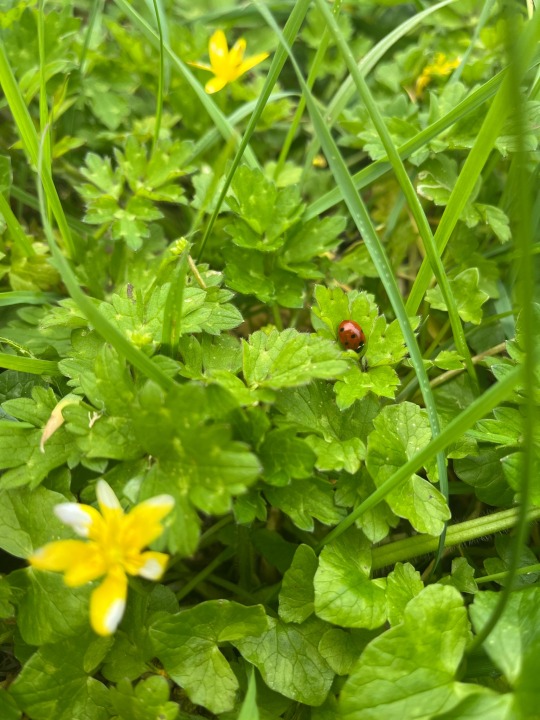
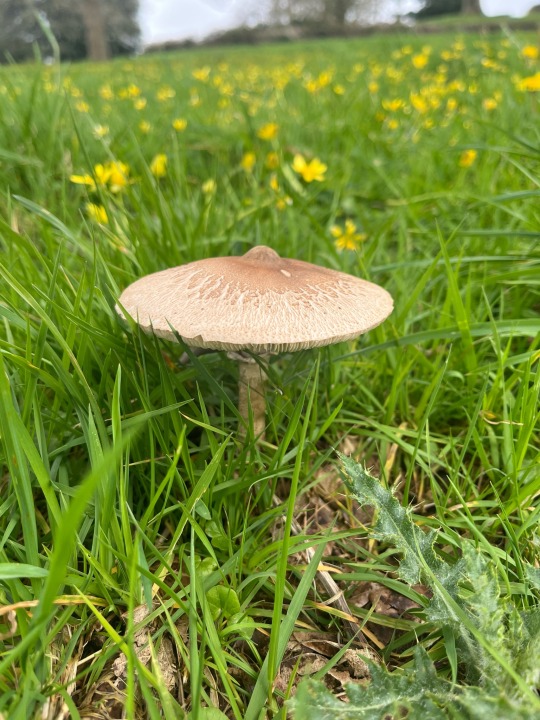
Out on a tiny adventure today was treated by Mother Nature with these beauties 🐞🍄
#micro nature#mini bugs#mini monsters#miraculous ladybug#ladybug#nature#nature photography#mushrooms#muddypuddles#happy family#family adventures#tiny adventure#i wanna be tiny#tiny lady bug#phone photography#mushroom photography#uk mushroom#british wildlife#British wild mushrooms#wild fungi#fungi
8 notes
·
View notes
Text
Flammulina? I can't identify fungi well. Photos I took on Saturday 18/11/2023, Potteric Carr, South Yorkshire, UK
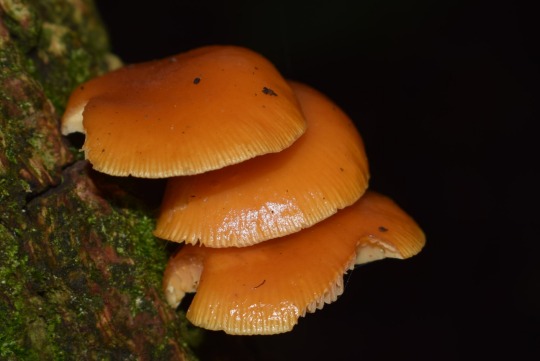
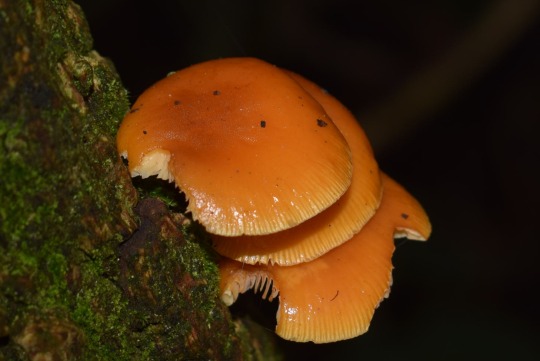
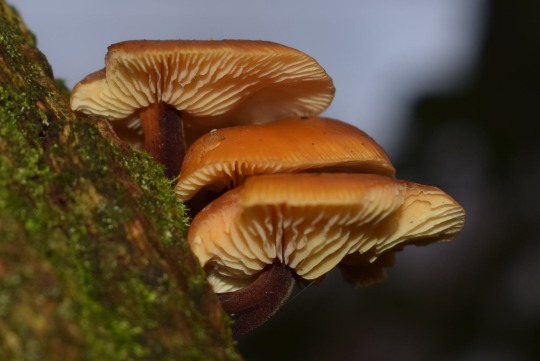
#nature#nature photography#british nature#wild#orange mushroom#orange#mushroom photography#mushroom posting#mushroom#mushrooms#toadstools#toadstool#fungiphotography#fungi photography#wild fungi#fungi#fungus photography#fungus#wild mushrooms#wild mushroom#wild planet#wild photography#uk nature#natural world#outdoors
36 notes
·
View notes
Text
the way mushrooms are named in this country makes it so clear they were named by early foragers lol - like here we have Sweet Buttery Little Goodboi of the Woods and her identical twin sister, The Orb of Kill You to Death
#I'm begging you to look at a list of british wild mushrooms#tag urself im Least Stinking Brittlegill or maybe Amethyst Deceiver#elise's posts
14 notes
·
View notes
Text


anyways i finally found some amanitas yesterday while out on a walk and they’re the cutest fucking things i’ve ever seen
#photography#british columbia#pnw photography#artists on tumblr#photograpers on tumblr#amanita#amanita muscaria#wild fungi#mushrooms
4 notes
·
View notes
Text

Silky ink cap
Yorkshire, England
16 notes
·
View notes
Text

Use Code: RACHELLAUREN for sly 20% off! CANADA WIDE SHIPPING.
#microdosing#mushrooms#mushies#wild fungi#fungi#fun girl#yyc#yycliving#calgary#edmonton#ontario#montreal#quebec#british columbia#420culture#420life#420stoner#420daily#420girl#cannabis#ganja
1 note
·
View note
Text
British Columbia says it is not ruling out regulating wild mushroom picking after an Indigenous community said a rising number of foragers are infringing on its land, with one case involving alleged threats of physical violence and intimidation. The provincial response comes after the Skwlax te Secwepemculecw First Nation said the areas devastated by the Lower East Adams Lake and Bush Creek wildfires last year are now sprouting large numbers of morel mushrooms, attracting many foragers who are putting new pressures on the land’s fragile ecosystem. “It’s what they leave behind that is the problem and the devastation, the damage they’re doing cutting trees down,” said Chief James Tomma. “We’re seeing the unwanted killing of the wildlife who are under a lot of stress right now and really vulnerable.” In a written statement, the B.C. Ministry of Forests said it is continuing to “monitor the situation and may take steps in the future, should circumstances indicate a change is needed.” [...]
Continue Reading.
Tagging: @newsfromstolenland
#cdnpoli#British Columbia#Indigenous persecution#environment#environmental racism#colonialism#First Nations#Skwlax te Secwepemculecw Nation
338 notes
·
View notes
Text
Anticipated New Releases of 2024
**As anticipated by Me. Mostly SFF. Links are to goodreads because that's what I use, sorry. Anything marked "new to me" I haven't read anything by that author before and therefore can't vouch for the quality. I just think the premise is neat.**
Emily Wilde's Map of the Otherlands, Heather Fawcett (16 January)
Sequel to the charming novel about the fairy anthropologist.
Exordia, Seth Dickinson (23 January)
Well, it isn't a new Baru Cormorant, but this modern SF about first contact may be the next best thing.
City of Stardust, Georgia Summers (30 January)
New to me. A young woman descends into the underworld in order to break her family's fatal curse.
The Tainted Cup, Robert Jackson Bennett (6 February)
New to me. A sherlock holmes flavored duo solves the mystery of the murder of an imperial official in a labyrinthine fantasy realm.
What Feasts at Night, T Kingfisher (13 February)
The sequel to the mushroom horror book What Moves the Dead.
The Warm Hands of Ghosts, Katherine Arden (13 February)
A ghost story set in WW1 about a woman searching for her missing brother.
The Fox Wife, Yangsze Choo (13 February)
New to me. A detective in 1908 Manchuria investigates a young woman's death in an area full of mythical foxes.
Redsight, Meredith Mooring (27 February)
New to me. Unpowered priestess and Imperial pawn is set on a collision path with a pirate with a grudge for the Imperium (Gay romance).
Sunbringer, Hannah Kaner (12 March)
Sequel about the professional godkiller Kissen.
Jumpnauts, Hao Jingfang (12 March)
New to me. A SF novel in translation from Chinese, with three scientists joining forces to deal peacefully with a first contact situation.
The Woods All Black, Lee Mandelo (19 March)
I liked Mandelo's debut novel very much so I'm excited to read this queer horror novella set in 1920s Appalachia.
Floating Hotel, Grace Curtis (19 March)
New to me. A series of cozy character vignettes on a space cruise ship after a murder has occurred. One of the four (!) space hotel murder crimes books coming out this year.
The Emperor and the Endless Palace, Justinian Huang (26 March)
New to me. Reincarnation gay romance set in 4 BCE China, the 1740s, and modern-day LA.
Alien Clay, Adrian Tchaikovsky (28 March)
Far future space xenoarchaeology by a man trapped on a prison planet.
Someone You Can Build a Nest In, John Wiswell (2 April)
New to me. Bizarre lesbian cannibalism monster romance from the point of view of the monster.
The Familiar, Leigh Bardugo (9 April)
Glad to see Bardugo writing more adult fantasy, and this one is especially exciting because it's a fantasy set in early modern Spain with a Jewish main character. Fun to see a more original historical period.
A Sweet Sting of Salt, Rose Sutherland (9 April)
New to me. Lesbian selkie romance.
Death in the Spires, KJ Charles (11 April)
Charles branching out from romance into historical Oxford murder mystery about a group of friends with dark secrets.
Audrey Lane Stirs The Pot, Alexis Hall (22 April)
The new Hall thinly veiled british baking show romcom. Libby says it's releasing in April but I've heard nothing from the author so I think it may be Alecto'd (shifted to next year)
Necrobane, Daniel M Ford (23 April)
Sequel to the dungeons and dragons-esque low fantasy lesbian necromancy book.
A Letter to the Luminous Deep, Sylvie Cathrall (25 April)
New to me. Sweet underwater epistolary academic romance.
How To Become the Dark Lord and Die Trying, Django Wexler (21 May)
New to me. A young hero caught in a fantasy time loop gives up and tries being the villain in an attempt to escape.
Goddess of the River, Vaishnavi Patel (21 May)
Another woman-centered retelling of Hindu mythology, this time based on the river goddess Ganga.
Escape Velocity, Victor Manibo (21 May)
New to me. Evil and toxic private school alumni jockey for position in a space hotel event in an attempt to escape a dying Earth.
The Fireborne Blade, Charlotte Bond (28 May)
New to me. Gay dragon slaying knight novella.
Evocation, ST Gibson (28 May)
New to me but looks very cool. Attorney and medium David attempts to escape his deal with the devil with the help of his ex boyfriend and his ex boyfriend's wife (Poly romance).
Service Model, Adrian Tchaikovsky (4 June)
In an SF future, a robot kills its human owners and ventures out into a world where human supremacy is beginning to crumble.
Lady Eve's Last Con, Rebecca Fraimow (4 June)
New to me. A con artist seeks revenge on the man who hurt her sister, who's coincidentally also on a space cruise ship (Sapphic romance subplot).
Triple Sec, TJ Alexander (4 June)
An actual mainstream published poly romance (!!) by trans author Alexander.
Running Close to the Wind, Alexandra Rowland (11 June)
Gay! Pirates! Scheming! Alt fantasy world! Monks! I liked Taste of Gold and Iron a lot and I'm very excited for this one.
The Knife and the Serpent, Tim Pratt (11 June)
New to me. Space opera about an interdimensional organization. Also, there's a sentient starship.
The Witchstone, Henry Neff (18 June)
A childhood favorite of mine's adult debut, featuring a demon who suddenly has to shape up at his curse keeper job after eight hundred years of slacking.
Rakesfall, Vajra Chandrasekera (18 June)
VERY excited to read more weird queer sff from this author after a fantastic debut. Looks weird. I'm in.
Foul Days, Genoveva Dimova (25 June)
New to me. A witch in a Slavic fantasy inspired world flees her evil ex, the Tsar of Monsters. There's also a plague and a detective.
Saints of Storm and Sorrow, Gabriella Buba (25 June)
New to me. Filipino inspired anticolonialist fantasy novel about a nun who is secretly practicing the religion of her goddess.
The Duke at Hazard, KJ Charles (18 July)
A queer regency with an incognito duke by one of my particular favorite romance authors.
Long Live Evil, Sarah Rees Brennan (30 July)
!!! Very excited to see a new adult fantasy by Brennan. A reader is dragged into a fictional world and finds herself the villain.
A Sorceress Comes to Call, T Kingfisher (20 August)
A retelling of The Goose Girl from reliably good fairy tale stalwart Kingfisher.
Buried Deep and Other Stories, Naomi Novik (17 September)
Collection of Novik's short stories.
Swordcrossed, Freya Marske (8 October)
VERY excited to see a new book by talented writer Marske. A man falls in love with the duelist hired for his arranged wedding. MEANWHILE. details of the fantasy world wool industry.
Feast While You Can, Mikaella Clements and Onjuli Datta (29 October)
New to me. Small town queer cave horror.
The Last Hour Between Worlds, Melissa Caruso (19 November)
Multiple reality murder mystery spy vs spy type antics, with lesbians.
#book recommendations#on the tbr#now I would Like to put alecto the ninth on this but as we know. NO news (sobs)#long post#updated 3/8 with more books I've added since I posted this
126 notes
·
View notes
Text
Y'all ever....
Does anybody else forget how many fandoms they're in because they're in a bunch?? Like I completely forgot about BATIM and DDLC until I was watching someone's livestream and they put on songs so we could guess the fandom it belonged to lol. I also forgot about MLP until I saw more stuff about a game called Pony Town and various MLP infection AU's. Wait, how many fandoms am I even in? Let's see....
MLP
Dead Plate
FNAF
Creepypasta
DDLC (sorta, so I'll count half ig?)
BATIM
Harry Potter
The Riordanverse (so if we count the series', this is 5 fandoms within itself lol)
Helluvaverse (2)
Your Boyfriend Game (I DO NOT SUPPORT FUBOO, I just like the fan art and fan comics)
The Last Apprentice
Mouthwashing (I'll count half for this one. Jimmy has become a literal trigger for me after finding out what he did to Anya, so I usually avoid anything containing him)
The Owl House
Welcome Home
Pressure
ETM (Epic the Musical)
HOLY SH!T THAT'S 20 FANDOMS! WAIT!
Shadow&Bone
COD (counting 1/2 bc I have not played any of the games, everything I know about - mainly Ghost and Soap - is from the wiki pages)
DSMP
MHA (1/2 since I never finished the show)
Ghosts (That TV show on Prime? Yeah, talking about that. Technically counts as 2, since there's the British original and the American Version...)
Rise of the Guardians (Poor Jack Frost. This movie is an underrated MASTERPIECE. And yet everyone seems to have forgotten it...)
SO THAT'S 25 JEEZ!!!
EDIT: SCP Foundation, and Homicipher (Homicipher is 1/2 bc I've never even watched a play through but I adore Mr. Crawling and Mr. Silver). Doors (roblox) too. So what, that's 27 and 1/2?
Edit #2: TADC. Idk how I forgot it. So 28 and 1/2. I know I'm forgetting something else, but I don't remember what?
Edit #3: Amanda the Adventurer and sorta Poppy Playtime? (so plus 1 and 1/2). Also Trevor Henderson creations, so that brings us up to a whopping 31 fandoms. What am I doing with my life y'all...?
Edit #4: Baldi's Basics. So 32 fandoms and still counting. Paw Patrol (at this point, just counting every fandom I had ever been in). So 33. Piggy makes that 34... omfg, what have I done with my life? If this is not a clear sign I'm mentally unstable, tell me what is. Song of the Sea is 35. That's not my neighbor makes it 36... I need to stop and go save myself while I can....
Edit #5: Mushroom Oasis (Mychael is f_cking adorable. YOU CAN'T CONVINCE ME OTHERWISE!!!), so 37. Child's Play and the Conjuring (talkin' movies here), that's 39.
Edit #6: Last edit for tonight bc my brain hurts. Baldur's Gate makes it 40. Yes I'm counting it fully bc I'm obsessed with Kar'niss and Astarion.
Edit #7: Seriously the last edit. Pound puppies bring it up to 41.
Edit #8: IM SORRY! BUT BEFORE I FORGET... Monster High, TMNT, Bubble Guppies, Bluey, and so many Disney movies but I'll only count the Disney category as one. So that brings us up to 5 more... so 46. I NEED TO BREATHE, OH MY GODS-
Edit #9: Team Umizoomie makes that 47. I'll count Undertale as 1/3 since I still listen to some of the songs but never really played the game and only dabbled in the Fandom. Kiranmala and the Kingdom Beyond (Ive only read the first book, but I think it's a series? First book is 'The Serpent's Secret' by Sayantani Dasgupta) brings us to a total of 48 and 1/3 fandoms. My brain hurts so much I'm starting to get cramps....
Edit #10: Seriously last edit for tonight bc I have dishes that NEED to get done, plus laundry. But Octonauts and Wild Kratts bring us up to 50 and 1/3. Add Yandere Simulator and you've got yourself a WHOPPING 51 AND 1/3 FANDOMS IN TOTAL! (For now, until I remember another, oof...)
Edit #11: Coraline and The Corpse Bride. Gotta love Tim Burton. And the Nightmare before Christmas. Ik I said I would only count Disney movies as one whole thing, but... I'm counting these three individually. So 51 and 1/3 plus 3.... 54 and 1/3.
#creepypasta#pressure game#etm#shadow & bone#the owl house#mouthwashing#fnaf#welcome home#the last apprentice#the riordanverse#ddlc#batim#harry potter#yb game#dead plate#mlp#Sorry for the rant! And to make matters worse#I prob forgot some...#rise of the guardians#dsmp#ghosts#mha
8 notes
·
View notes
Text
Black Butler manga foods/drinks
I'm sure I missed some things, but it was all things that weren't really named or specified, or I couldn't tell with certainty what they were. @sebastian-ciel-mutual-bullying this is for you! feel free to take and use as you need o7 Book 1 breakfast: poached salmon and mint salad with toast, scones, and pain de campagne on the sides, ceylon tea horribly salty lemonade dinner: Japanese green tea, gyuutatakidon, Italian red wine, apricot and green tea mille-feuille dessert: orchard fruit cake with pears, plums, and blackberries dessert: deep-dish apple raisin pie milk
Book 2 assam tea afternoon tea: keemun and summer pudding of currants and other berries lunch: stuffed cabbage and minted potato salad chocolate earl grey afternoon tea: cornmeal cake of pears and blackberries salty rosehip herbal tea
Book 3 hot milk with honey or brandy peeled apple assam tea with milk oranges with shalimar tea steak and kidney pie and salmon sandwiches messy birthday cake and donburi strawberry-decorated birthday cake
Book 4 fish chai with ginger breakfast: shrimp curry and French toast with ginger mackerel with gooseberry sauce and cottage pie
Book 5 British-style Bengali chicken curry chicken curry afternoon snack: gateau au chocolat beef curry blue lobster with seven curries curry bun assam tea white darjeeling tea champagne sushi
Book 6 Christmas pudding cookies shaped like bones fish and chips, meat pies, bread
Book 7 rice porridge dinner: milk risotto with a three-mushroom medley, a pot-au-feu of pork and wine, and a warm apple compote with yogurt sauce
Book 8 oranges afternoon tea: chocolate macarons with fruits and three-berry shortcake
Book 9 custard cream puffs red wine white wine brunch: herring pie and spinach quiche dinner: curry, and chopped vegetables for an appetizer
Book 10 dinner: soybean hamburg steaks
Book 11 elevenses: darjeeling tea and petits fours tonkatsu, shougayaki, tonjiru, tonshabu, yakiton
Book 12 cake with strawberries on top
Book 13 spiny lobster saute, roast turkey, sticky toffee pudding, fairy cakes (cupcakes) warm milk with honey
Book 14 watered-down darjeeling tea darjeeling tea dinner: roast duck and gateau chocolat
Book 15 golden syrup sponge pudding tea cakes lemon myrtle souffle glace with milk tea
Book 16 lunch: beef mince pie
Book 17 dessert: strawberries, cream, and meringue (Eton mess) with a side of iced summer pudding
Book 18 chicken pie coffee and walnut cake
Book 19 ravioli (maultaschen) and wurst soup, stewed pork with herbs and spices (eisbein), and rote grutze (sour berries boiled and chilled to jelly, served with cream) evening snack: caramel macarons, coffee cream eclairs, dark chocolate florentines. black tea ceylon tea
Book 22 earl grey tea with orange almond cake and berry tarts
Book 23 smoked salmon sandesh (milk sweets)
Book 24 soft licorice candy apples
Book 25 berry-filled pudding fish and chips and steak and ale pie gulab jamun (fried balls of dough drenched in syrup)
Book 29 kidney pie, fish and chips, and ale wild-hare pie tapioca steak
Book 30 nilgiri tea breakfast: pea soup, meatballs, croissants, boiled egg, orange jelly chicken and steamed vegetable salad, oxtail stew, pain de campagne with butter oolong tea
Book 31 candy cigarettes
28 notes
·
View notes
Text
The Penny Bun
This is one of the best eating mushrooms available from the wild. This mushroom even looks edible, with its domed brown cap looking like a Victorian bread bun that at the time cost a penny, giving it it's British name 'penny bun'

#Original Art#drawing#Pen And Ink#Colour Pencil#Mixed Media#Sketching#Mixed Media Drawing#Color Pencil#Gouache#ink drawing#Line Drawing#ink#Ink Art#painting#artwork#art#Traditional Art#Scottish Artist#Made In Scotland#Mushrooms#Mushroom Drawing#Fungi#Mushroom Art#Fungi Friday#Gift Ideas#Etsy
8 notes
·
View notes
Text
A Vegan Christmas Dinner To Remember
The Christmas table becomes the beating heart of the season in the dazzling December embrace, when frost kisses windows and songs flow through the air. Rather than turkey and gravy, more and more people are opting for tempeh and plant-based velouté this year, giving the ritual a daring and humane spin. A vegan Christmas meal is elevated to a magnificent feast befitting the enchantment of the season at Laki Kane, a tropical gem in London.

"A holiday is a celebration of connection," Maya Angelou once said, and the statement couldn't be more spot-on at Laki Kane, where each meal embodies the story of flavour, sustainability, and innovation. A growing number of people are opting for plant-based diets; in fact, more than 4.5 million Britons now identify as vegans or vegetarians. In keeping with the spirit of the season, Laki Kane provides a memorable and tantalising Christmas dinner that is also stylish and ethical.
Even on the coldest winter nights, Laki Kane, a festive feast unlike any other, radiates warmth and vibrancy from its location in the centre of Islington. As soon as you open the majestic doors, you will be whisked away to a tropical paradise where the air is thick with the tantalising scent of spices, verdant foliage, and sparkling fairy lights. Not your run-of-the-mill vegan joint; more like a festival honouring good eats, creative expression, and community.
Rather than just using vegan ingredients, Laki Kane's vegan Christmas feast completely revamps traditional holiday fare. Careful preparation goes into every item on the menu, which features a combination of seasonal British ingredients and exotic flavours influenced by the tropics. So what happened? An intimate Christmas dinner that transports diners on a gastronomic adventure.
The Menu: A Delectable Arrangement of Plant-Based Delights In the heart of Laki Kane's festive offering is a carefully selected cuisine that satisfies every need. Serve visually and gustatorily stunning appetisers to kick off your evening. Infused with delicate notes of ginger and lime, this velvety, warming butternut squash and coconut velouté is the ideal seasonal and tropical tribute. Complementing it is the Taro Root Croquette, which has a crunchy exterior and a lusciously soft interior. It is garnished with a spicy tamarind sauce.
In terms of the main dish, the Stuffed Jackfruit Wellington is head and shoulders above the conventional version. The jackfruit is wrapped in golden, flaky pastry and seasoned with a blend of warming spices. It's accompanied with wild mushrooms and chestnuts, which add a rich, earthy flavour. Side dishes like as maple-glazed Brussels sprouts with pomegranate pearls and cinnamon-roasted parsnips are a joyous tribute to the wealth that is celebrated during the holiday season.
Keep some space in your diet for dessert, though, because no vegan holiday meal is ever truly complete without a sweet treat. Indulgence triumphantly unfolds in the Spiced Chocolate Ganache Tart, adorned with candied orange peel and presented with coconut vanilla cream. Everything about this dish exemplifies Laki Kane's mastery of vegan luxury.
Festive Drinks That Bring Out the Season Every dish at Laki Kane is meticulously and artistically prepared, and no visit is complete without a distinctive drink. As a special holiday offering, the mixologists have crafted a selection of vegan cocktails that will go wonderfully with the vegan Christmas meal.
An example of a novel take on classic mulled tastes is the Winter Citrus Cooler, which mixes blood orange and cranberry with aged rum. The Golden Coconut Martini, on the other hand, is a velvety delight because to its coconut cream, turmeric, and ginger flavours. Choose from a variety of drinks that will complement each dish, whether you're in the mood for something light and refreshing or something rich and comforting.
Integral to the Festivities: Sustainability The dedication to perfection at Laki Kane goes beyond just the food. From using only locally grown ingredients to packaging their vegan Christmas dinner in eco-friendly materials, they think about the environment at every step of the process. Reflecting the genuine spirit of giving over the holiday season, the restaurant's zero-waste concept guarantees that nothing goes underutilised.
The commitment to sustainability strikes a chord with modern eaters, who are looking for experiences that reflect their beliefs. Not only do patrons of Laki Kane enjoy a memorable vegan Christmas dinner menu, but they also help to create a more considerate celebration atmosphere.
A Tropical Christmas: Setting the Scene As the snow softly falls on London streets, entering Laki Kane is like stepping into a tropical winter wonderland. An amazing fusion of tradition and innovation characterises the restaurant's holiday décor. A one-of-a-kind ambiance is created by golden decorations reflecting candlelight, exotic bloom-adorned pine garlands, and a dash of tropical flare in every nook and cranny.
On some nights, you can hear live music, and it's even more magical when it's acoustic versions of seasonal favourites. Private dining rooms provide a cosy atmosphere for bigger gatherings, perfect for celebrating the holidays with friends, family, and coworkers. Laki Kane is without a doubt the greatest place in London to have a vegan Christmas dinner thanks to its welcoming atmosphere, delicious vegan dishes, and skilled chefs.
Customer Reviews: Real People Tell Their Story Vegan veteran Emma Porter said, "I've been to many vegan Christmas dinners in London, but nothing compares to Laki Kane." Everything on the menu was out of this world, with dishes that were both inventive and tasty. It wasn't merely an accommodation; it was a genuine celebration.
I wasn't sure what to anticipate, but Laki Kane totally transformed my view on vegan food," confessed Jack Miller, who openly admits to wanting meat. It felt like the ideal Christmas, and the Jackfruit Wellington was absolutely divine.
Much More Than Just Food, It's an Occasion Vegan Christmas dinner menu by Laki Kane is beautiful because it may bring people together regardless of their dietary preferences. What matters is not what is absent, but rather what is conceivable. At Laki Kane, we want to bring you the joy of the season with each dish, drink, and moment by adopting a sustainable and compassionate eating experience.
A Pleasure to Have You Join Us for the Season As iambic pentameter's melodic cadence:
A meal prepared with care relieves the gloom upon a wintry eve where tastes thrive. Delicious plant-based meals are served at Laki Kane, A Christmas story about happiness in the dark.
Laki Kane provides vegans looking for a memorable vegan Christmas dinner menu with an experience that lasts long after the last bite has been eaten. It is a must-visit spot this Christmas season since the spirit of the season is evident in every element, from the cuisine to the decor.
3 notes
·
View notes
Text
Wilde is not a Social Class
part 1: What "Civil" and "Wilde" really meant
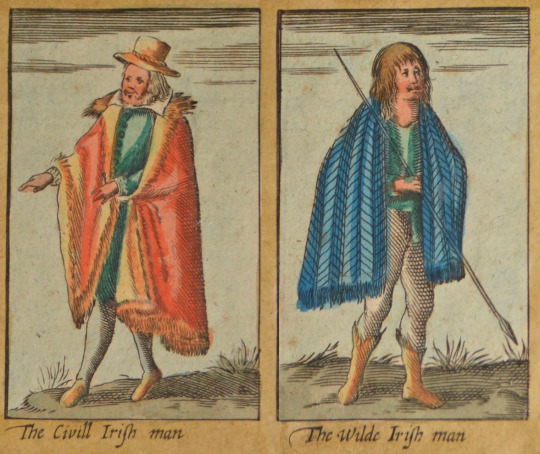
The "Civill" Irish man and the "Wilde" Irish man from a 1676 colorization of John Speed's 1611 map of Ireland
“the wilde men in Ireland, properly called Woodkarne . . .”
-John Derrick “The Image of Irelande” 1581
The labels ‘civil’ and ‘wilde’ show up in several 16th and 17th century depictions of Irish people. These include an illustration by Lucas De Heere, John Speed's map of Ireland, and John Derrick's The Image of Irelande, which are all frequently used as sources in Irish dress history. Many modern viewers have misinterpreted these terms as indicators of socioeconomic status or social class with 'civil' interpreted as meaning middle class and 'wilde' interpreted as poor. (Dunlevy also specifies that 'civill Irish' means the '(non-military) middle class'. The word civilian did not acquire the meaning 'not part of the military' until the 19th century, so it is not applicable to 16th and 17th c. usage.) This misconception about the historical meaning of these terms distorts our understanding of how the Irish dressed during the 16th and 17th centuries. In order to accurately interpret these images, we first need to understand how the terms 'wilde' and 'civil' were actually used during this period.
In this post, I will discuss what these terms meant historically, how they were used in 16th and 17th c descriptions of the Irish, and what they are actually telling us about the Irish people in Speed's illustrations.
The terms 'wilde' and 'civil' were used not by the Irish themselves but instead by the British and continental Europeans to describe the Irish (Dunlevy 1989). John Speed and John Derrick were English; Lucas De Heere was a Flemish artist who never went to Ireland and was given information about the Irish by the English (McClintock 1943).
Randle Cotgrave's A Dictionarie of the French and English Tongues, published in 1611, gives us a period definition of civil. It defines Civil as: "civill, courteous, gentle, mannerlie, well-behaved; also, temperate, mild, quiet; also, towne-bred, or burguerlike; also, politicke, lay, secular, civill." There is nothing about wealth or social class in this definition. Civil instead means civilized; it refers to a person's behavior or urban residence.
The concept of the wild man as the antithesis of urban-dwelling, civilized man is as old as civilization itself, with the oldest recorded example being the ancient Sumerian figure of Enkidu from the stories of Gilgamesh. It shows up in ancient Greek and Roman texts as monstrous wild men being said to live in foreign places like Libya and Ethiopia. In Christian Medieval Europe, wild men became a hairy subhuman race separate from, yet living near, civilization (Husband 1980).
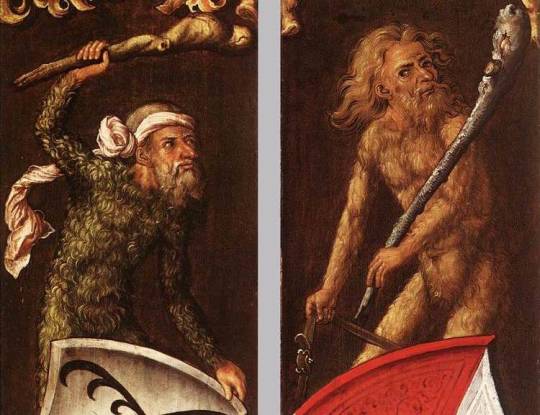
2 Wild Men by Albrecht Dürer, 1499
Medieval wild men and women had long, unkempt hair, wore little to no clothing, and fed on wild plants and raw meat rather than farming. They were characterized as violent, brutish and irrational. Because of their proximity to nature, they were sometimes portrayed as having an unusually close relationship with animals, able to ride horses without a saddle or bridle (Husband 1980).

Wild man riding with no bridle and sticks for a saddle c1480 by Ludwig Schongauer
Although the hairy wild man of the late Middle Ages was a mythical being, this barbaric, uncivilized archetype clearly influenced 16th and 17th c portrayals of the Irish.
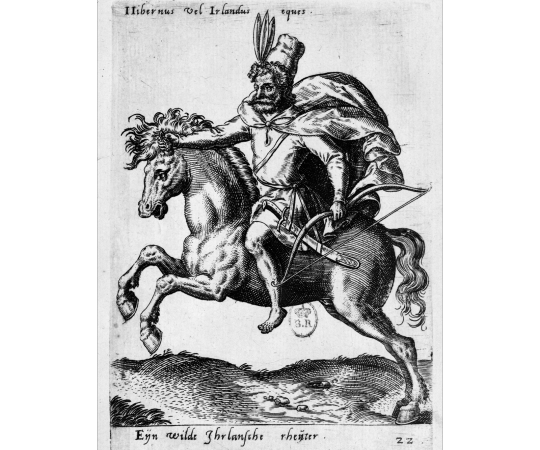
Abraham De Bruyn's c1578 "wild" Irish rider rides bareback and bridleless, in spite of the fact that the 16th c. Irish used saddles and bridles. John Speed writing in 1611 implies the complete Irish diet was watercress, roots, mushrooms, shamrocks, butter with oatmeal, milk, whey, raw meat, and congealed blood with butter. This list fits nicely with a wild man's no-farming lifestyle and conveniently omits the bread, roast mutton, meat pie, and alcohol mentioned in other period accounts of Ireland (ex Gernon 1620, Vital 1518).
These conceptions of 'wild' and 'civil' played an influential part in British colonialist policies in Scotland and Ireland. The 16th c English and King James the VI and I considered the Gaelic Irish and Highland Scots to be barbaric and the English and Lowland Scots to be civil. The plantations of Ulster and the Isle of Lewis were created as part of a series of attempts by the British crown to 'civilize' these areas (i.e. eradicate Gaelic culture). In a 1607 letter about the plantation of Lewis, King James I called the settlers "civile gentlemen" and the native Scots "wilde weedes" (Brochard 2019).
Earlier attempts by the British to "civilize" Ireland involved banning Irish culture. A 1537 statue of Parliament stated that people in Ireland were savage and wild, because of . . . cultural diversity. Yes, really.
"There is [. . .] nothing which doth more conteyne and keep many of [the King's] subjects of this his said land, in a certaine savage and wilde kind and maner of living, then the diversitie that is betwixt them in tongue, language, order, and habite, which by the eye deceiveth the multitude, and perswadeth unto them, that they should be as it were of sundry sorts, or rather of sundry countries, where indeed they be wholly together one bodie . . ."
-An Act for the English Order, Habite, and Language, Rolls of Parliament cap. 26, 28th year of Henry VIII (1537). (cited in Butler 1786). (emphasis added)
King Henry VIII was apparently afraid that the "savage" manner of living practiced by the Irish (i.e. speaking Irish, following Brehon law, and wearing Irish clothing, instead of using English language, customs, and clothing) would persuade the rest of Europe that the British Isles were not, in fact, one happily united kingdom. Of course, instead of just letting England and Ireland to be sundry countries, his solution was to ban Irish language and clothing. This policy was continued by later 16th c. British colonial administrators in Ireland.
"The inhabitants of the cities and corporate towns shall wear no mantles, shorts [sic] Irish coats, or great shirts, nor “suffer their hair to grow glebb, but to wear clerks’ gowns, jackets, jerkins, and some civil garments;” and no maid or single woman shall “wear or put on any great roll or kercher of linen cloth upon their heads, neither any great smock with great sleeves, but to put on hats, caps, French hoods, tippets, or some other civil attire upon their heads;”
-1571 Laws and ordinances proclaimed at Limerick by Sir John Perrot, Lord President of Munster [. . .] to be observed throughout that province (cited in Carew 1867). (emphasis added)
The permitted "civil" garments: gowns, jackets, jerkins, hats, caps, French hoods, and tippets were items worn in England during the 16th c. (Mikhaila & Malcolm-Davies 2006) while the banned garments: bratanna, ionair, léinte, linen rolls, and kerchiefs, and the hairstyle, glibs, are Irish fashions (Dunlevy 1989, McClintock 1943).
These examples make it clear that to 16th and 17th c artists like John Speed 'civil' meant English and 'wilde' meant Gaelic Irish. The "Civill Irish man" was anglicized. He spoke English, wore English clothing styles, and followed British laws. The "Wilde Irish man" remained culturally Gaelic. He spoke Irish, wore Irish clothing, and followed Brehon law. 'Civil' and 'wilde' did not indicate level of wealth; they indicated level of acculturation.
In part 2 of this post, I will discuss how well the interpretation that the 'wilde' Irish were poor and the 'civil' Irish were middle class matches what we actually know about dress in 17th c Ireland. Was acculturation level actually correlated with wealth?
Acknowledgement: I would like to thank the members of the reenactment group Wilde Irish for making me aware of this subject.
Bibliography:
Brochard, Thomas (2019). Plantation: Its Process in Relation to Scotland’s Atlantic Communities, 1590s–1630s. Journal of the North Atlantic, Special Volume 12, 73-94. https://www.jstor.org/stable/27133161
Butler, James G. (Ed.) (1786). The Statutes at Large, Passed in the Parliaments held in Ireland (Vol. 1). George Grierson, London.
Carew, George (1867). Calendar of the Carew Manuscripts, 1515-1574 Preserved in the Archiepiscopal Library at Lambeth. (J.S. Brewer, & W. Bullen, Eds.). Longsman, Green, Reader, & Dyer, London.
Cotgrave, Randle (1611). A Dictionarie of the French and English Tongues. Adam Islip, London.
Dunlevy, Mairead (1989). Dress in Ireland. B. T. Batsford LTD, London.
Gernon, Luke (1620). A Discourse of Ireland.
Husband, Timothy, & Gilmore-House, Gloria (1980). The Wild Man: Medieval Myth and Symbolism. The Metropolitan Museum of Art, New York.
McClintock, H. F. (1943). Old Irish and Highland Dress. Dundalgan Press, Dundalk.
Mikhaila, Ninya, & Malcolm-Davies, Jane (2006). The Tudor Tailor. Quite Specific Media Group, Ltd, London.
Speed, John (1611). The Theatre of the Empire of Great Britaine: presenting an exact geography of the kingdomes of England, Scotland, Ireland, and the iles adioyning. William Hall, London.
Vital, Laurent (1518). Archduke Ferdinand's visit to Kinsale in Ireland, an extract from Le Premier Voyage de Charles-Quint en Espagne, de 1517 à 1518. translated by Dorothy Convery.
#decolonizing history#irish history#irish dress#gaelic ireland#stair na héireann#16th century#17th century#art#british colonialism#dress history#historical dress#statutes and laws
17 notes
·
View notes
Text










16.07.24 - Young Darwin Scholarship Day 2
Today was much harder going than yesterday. I was suddenly hit by immense tiredness which made things very hard and I had to sit out for a chunk of the day which frustrated me. It was still an interesting day over all. In the usual fashion I will go through photos.
1. The first task of the day was to check the traps we set last night. As a group we set 15 traps in the hedgerows round the perimeter of a field. 5 bank voles were caught. They are beautiful little animals with reddish brown fur on their backs although it is hard to see in this photo in which the sex of the vole is being determined.
2. Details of the voles we caught
3. Some simplified diagrams for a quiz on all the small mammals we were taught to identify (apart from the Greater White-toothed Shrew). Small mammals are defined as those that weigh less than 100g as adults.
4-6. I don’t know what the first and third mushrooms are but the middle one is a Goldenhaired Inkcap mushroom (Parasola auricoma).
7-8. Insects identified: The first is the Black Arches or Nun Moth (Lymantria monacha) sitting in the middle of the path at the field centre in broad daylight. It was alive, maybe stunned? The second is a Littoral Whiplash Rove Beetle (Paederus littoralis) at the National Nature Reserve.
9. A twig colonised by lichen I just had to photograph. There were many lichen covered trees at the nature reserve but I didn’t have time to stop and photograph them.
10. Me unsuccessfully looking for wild otters in the evening (and looking up signs of otters on my phone because I saw movement in the water I couldn’t identify the cause of). It was a nice peaceful location even if the otters didn’t appear.
I didn’t have the stamina to cut down bracken and other plants obscuring the paths through the forest unfortunately. Feeling woozy and tired and handling a big saw is not a good combination. There was also a career talk I found stressful because given how things currently are planning for the future is tricky. During the session I discovered the British Lichen Society which I signed up to and I hope that at least will be a positive thing.
#scholarship#naturalists#ecology#wildlife conservation#natural history#not-so-daily positives#photos#personal#wildlife#oops I only just remembered to do this!
2 notes
·
View notes
Text
The gaucho Martín Fierro, the creation of poet José Hernández, is one of the great figures of Argentinian literature: a singer who relates the camaraderie and hardship of cowboy life. But in Cámara’s International Booker-shortlisted novella, first published in Spanish in 2017, he’s a bit-part player in a wild trip across the pampas that leaves traditional gender roles in the dust.
The book follows China, Fierro’s neglected wife, who leaves her poor village to join a Scottish adventurer called Liz who has a wagon well stocked with curry leaves, cakes, lavender-scented sheets and literature. The pair travel across the plains towards an army camp and the territory of the Iñchiñ people, where Liz has a land claim. Nature is ever-present: the guinea pig tunnels that honeycomb the pampas, the limpid rivers of the north, the heat that sets the land ablaze “like a wet stone in the midday sun”.
The Adventures of China Iron sets British industry and Argentine expansion against the sisterhood of the wagon and an indigenous society of fluid genders and magic mushrooms. Sentences bound on from one page to another, seeming almost as long as the vignette-like chapters, in a thrilling and mystical miniature epic. This story, drunk on words and visions, is an elegy to the land and its lost cultures.
2 notes
·
View notes
Text
a random confession for munday
I honest to god hate yogurt so much. The fermented taste just tastes rotten to me. Like im eating rotten thick milk. I bought coconut based yogurt once to give er a shot and it was still a nope. They focused hard on that nasty ass rotten fermented taste. Greek yogurt, flavoured probiotic ones, high fat, low fat, dairy alternatives, it don’t matter it all tastes like expired rotten nasty ass milk to me.
oddly enough i do like sour creme. Like a small amount. I’m a minimalist dipper. I like me a smidge. Too much and I can’t handle too much of the bubbly fermentation taste. The Ukrainian genes kick in a little there, gotta fuck it up with sour creme with fried kubasa and perogy. It’s something about that in between yogurt taste I just can’t handle. Yogurt in things I don’t mind. Like tzatziki, dill dip, or naan bread. Mostly cuz the superior garlic hides that taste i hate.
am I alone in my hatred for yogurt? I feel like when i tell people i hate yogurt i’m met with shock and awe. Then I get treated like a child for not liking it. I’ll fuck it up with some weird foods but I can’t do yogurt. I don’t think I’m that picky an eater. We all got preferences. And I’ll try anything once, twice if it’s been something my child self hated but I’ll see how my adult pallet handles it. It’s quite the privilege to have these kinds of preferences and options.
I also get flack for mushrooms. I don’t like em. Loved them as a kid but now I just dislike it. Cooked mushrooms are gross. Raw ain’t so bad. They’re so rubbery and taste like dirt. I hate ketchup too. What a way to ruin the flavour of a dish by putting ketchup on it. Like do you just hate food where you feel the need to put sweet tomato vinegar sauce on it? You’re unhinged with the pallet of a 3 year old.
but to redeem myself I did start trying beans more. It’s a texture thing I’m trying to adjust to but I find I don’t mind it in things like chili. I’m curious to try a burrito with beans sometime. But beans and toast is fucking wild British people scare me with their mushy ass food.
4 notes
·
View notes